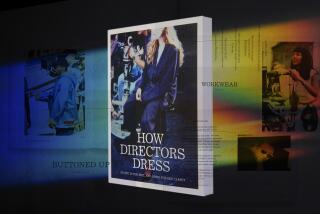GLAM IS A CINCH
- Share via
“Revolutionary Road” is not an easy film to watch, with its brutal dissection of suburban malaise and bitterness. Directed by Sam Mendes, who knows the rocky emotional territory (“American Beauty”), “Road” stars his wife, Kate Winslet, and Leonardo DiCaprio as April and Frank Wheeler, a couple whose youthful dreams of an interesting life have died a slow death in the Connecticut ‘burbs in the mid ‘50s. “Road’s” Oscar-nominated costume designer Albert Wolsky talks about the challenges of the post-WWII-era fashions, which were not yet the sleek “Mad Men” silhouettes we mistake for ‘50s styles.
“Revolutionary Road” is set in a time that people are starting to be familiar with because of the AMC show “Mad Men,” but they don’t look the same in this film.
Everyone thinks it’s the same period, but it’s probably 10 years earlier. And there’s a vast difference in a decade. There’s so much of the early ‘50s still coming from the ‘40s, whereas by the time you get to the early to mid-’60s, the ‘40s have totally gone, it’s all ‘50s influence.
--
You can see the ‘40s’ touches in this film, like the nipped-in waist for the women, the slightly fuller pant for men.
Yes, the broadness of the ‘40s on the men, the big padded shoulders start to come down, but there’s still fullness to men’s suits. Women’s skirt lengths are still fairly long, in fact, quite long in the early ‘50s, as a reaction to the ‘40s, after the war where skirts were so short.
During the war, women were working, so their clothes were more masculine. To save fabric, women used men’s suits and made skirts out of the pants. As soon as the war was over, or as soon as it was economically possible, there was a feeling of wanting to go back to feminine clothes and not be in charge anymore.
--
Kate’s character sees herself as special, being artistic and slightly above everyone else. How does that come through in her clothing?
At the happy birthday party in the flashback when she was wearing the black dress, that’s one time you see her in a dress with an artistic flair. That’s her most adventurous moment, where the hair’s long and straight, and she’s dressed the most like an actress or a model. Later, she becomes the housewife and it’s much more structured, but she always looks slightly different. If she goes to the neighbors, she’s in a tighter, much more sleek-looking dress as a subtle way of keeping her apart without really nailing it, so you go, “Oh, my God, look at her!”
--
Tell me a little bit about that scene with all those fedora-wearing men getting off the train to New York.
It was a different time. Women wore gloves and men wore hats. Now, sure there were some men in that day who were hatless. But I thought it would be much more interesting to have a sea of hats in that scene. It told the story of his going from Connecticut to Grand Central. When I do period, I try to find something that nails that period. By accentuating it, exaggerating it, you get a feeling, a stronger feeling of the period.
--
Kathy Bates’ costumes seemed earlier than the ‘50s, like she was trapped in the previous decade.
I kept her a little more old-fashioned. In those days, high fashion from Paris didn’t go right to the streets right away, the way it does now. Kathy Bates’ costumes are barely out of the ‘40s.
--
Was it tricky getting Leo in that ‘40s feel?
He took to it immediately. Our only caveat together was that men wore their pants down to around their ankles. I said, “Leo, the pants have to be up against your waist, and he looked in the mirror, and we pulled up the pants to where they need to sit, and he said, ‘Really?’ So the rest of the movie, his dresser had to keep pulling his pants up. But he totally understood.
More to Read
Only good movies
Get the Indie Focus newsletter, Mark Olsen's weekly guide to the world of cinema.
You may occasionally receive promotional content from the Los Angeles Times.










